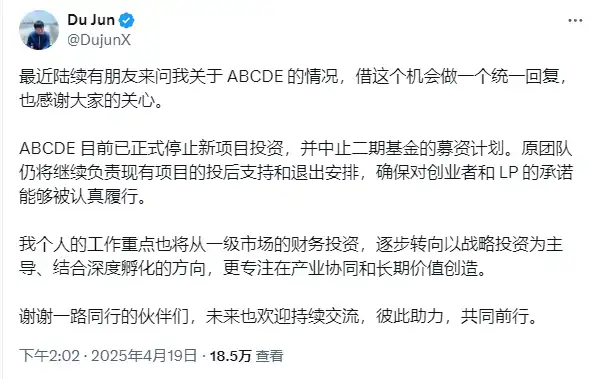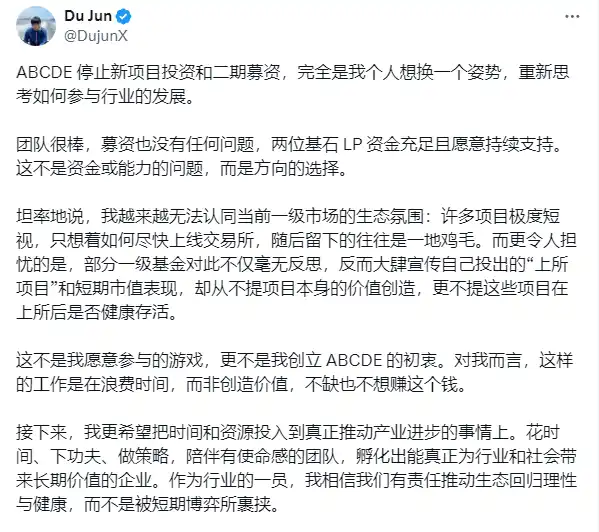Life and Death Struggle in the Primary Market: How Can Blockchain Venture Capital Navigate the Value Crisis Cycle?
Future investments should focus on underlying protocol innovation, middleware value capture, and application layer breakthroughs, rebuilding trust in the foundational infrastructure.
Original Title: "Blockchain Primary Market Dilemma and Breakthrough: From Value Confusion to Ecosystem Reconstruction"
Original Author: Lawrence, Mars Finance
1. Industry Mirror of Du Jun's Manifesto: Structural Contradictions in the Primary Market Exposed

Founder of ABCDE Capital, Du Jun, announced the decision to suspend new investments and the second-phase fundraising plan, resembling a touchstone plunged into the depths of the blockchain industry, sparking ripples that reflect the systemic contradictions existing in the primary market.

This industry veteran, who has been involved in heavyweight institutions such as Huobi and Node Capital, used sharp expressions like "short-sighted game" and "value creation loss" to pinpoint the industry's core malaise: in the frenzy of token liquidity, the original intention of the blockchain technology revolution is being alienated by exchange platform market value management and institutional arbitrage games.
This alienation exhibits significant features at the data level: according to CoinMarketCap statistics, in the first quarter of 2025, there were 327 new exchange platform projects launched globally, but only 12% of these projects continued positive technical iterations three months after listing, with the average token price falling by 67% compared to the opening price.
Of more concern is that some institutions, through the industrialized assembly line operation of "private placement - listing - market value management - exit," have compressed the investment cycle to 6-8 months, causing numerous projects to devolve into abnormal products of "code shells + economic model packaging."
The deep-rooted cause of this phenomenon lies in the blockchain industry's unique "triple misalignment":
· Temporal Value Misalignment: The traditional VC's 7-10 year exit cycle has been compressed to 18-24 months under the impact of token liquidity, causing a reversal in the technology incubation period and capital return period.
· Valuation System Misalignment: Network effects of protocol projects have not yet materialized, while market value has already pre-assumed the future 5-10 year value through token models.
· Responsibility Boundary Misalignment: Institutions have simplified post-investment management into exchange platform docking services, neglecting technical roadmap adjustments and ecosystem co-building responsibilities.
This systemic distortion is devouring the industry's innovative momentum.
As indicated by data from the Gitcoin developer forum, blockchain original protocol code commits in Q1 of 2025 saw a 23% year-on-year decline, while the number of token economic model whitepapers surged by 178%. We must face the fact that the industry is transitioning from a technology-driven value internet to a liquidity casino dominated by financial engineering.
2. Value Reconstruction Coordinate System: Technological Anchors and Investment Logic Reset for the Next 3-5 Years
Amidst the fog of liquidity abundance and value disorientation, reconstructing investment logic requires a return to the fundamental attributes of blockchain technology—creating a new trust infrastructure through cryptography and distributed consensus. Based on technological evolution trends and real-world economic needs, the key areas worthy of focused investment in the future exhibit three main characteristics:
(1) Breakthrough Innovation at the Protocol Layer
Interoperability Protocol
The current "island effect" in the public chain ecosystem severely restricts application implementation. Cross-chain protocols such as Cosmos IBC and Polkadot XCM need to achieve a qualitative breakthrough. The next-generation protocols should possess:
· Sub-second atomic swap capability (currently averaging 3-8 seconds)
· Heterogeneous chain smart contract interoperability framework
· Dynamic fee model to resist sandwich attacks
· Such technological breakthroughs will unlock trillions of dollars in cross-chain liquidity, giving rise to new financial protocols and data markets.
Commercialization Engine for Zero-Knowledge Proofs
Privacy computing technologies like zk-SNARKs are transitioning from being a "cryptographic toy" to business infrastructure. Investment focus should shift towards:
· Hardware-accelerated zkVM (e.g., RISC Zero architecture optimization)
· Composable privacy data markets (e.g., healthcare data, supply chain finance scenarios)
· Compliance-auditable proof systems
· According to ABI Research, the market size related to zero-knowledge proofs is expected to exceed $4.7 billion by 2028, with a CAGR of 62%.
Decentralized Storage Protocol Reconstruction
The security crisis of traditional centralized cloud storage (e.g., the 2024 AWS outage resulting in a $3.7 billion loss) has spurred new demands:
· Content-addressed permanent storage protocols
· Storage proof and economic model innovations (e.g., Filecoin Virtual Machine)
· Enterprise-grade storage compliance solutions
· This field will give birth to the "digital Noah's Ark" of the Web3 era.
(2) Value Capture Revolution at the Middleware Layer
DeFi 3.0 Liquidity Protocol
Going beyond the current AMM/DEX paradigm, the next-generation protocol needs to address:
· Impermanent Loss Dynamic Hedging Mechanism
· Cross-chain Liquidity Aggregator
· Compliant Stablecoin Payment Rail (e.g., Fully Reserved Collateralized Stablecoin) 9
· Circle's Q1 2025 report shows a 320% year-on-year growth in cross-border payments using compliant stablecoins, validating the potential of this direction 9.
DAO Governance Infrastructure
The current dilemma of DAOs with less than 15% voter turnout calls for technological breakthroughs:
· Behavior-based Dynamic Reputation System
· Multi-Level Delegated Proxy Framework
· On-chain/Off-chain Governance Hybrid Engine
· Such tools will propel DAOs from being a "governance toy" to a "digital economic operating system".
Physical Asset Tokenization Protocol
Bringing traditional financial assets onto the blockchain requires overcoming three major bottlenecks:
· Legal Entity to Smart Contract Rights Mapping
· Dynamic Valuation Oracle Network
· Compliance Settlement Mechanism
· The Boston Consulting Group predicts that by 2030, the market size of Real World Asset (RWA) tokenization will reach $16 trillion, nurturing structural opportunities.
(III) Application Layer Paradigm Shift Opportunities
Decentralized Social Graph
The data monopoly of Web2 social platforms is driving new demands:
· User Sovereign Data Storage Protocol
· Social Relationship On-chain Credential System
· Anti-censorship Content Distribution Network 7
· Protocols like Farcaster have proven that decentralized social networks can achieve a DAU comparable to traditional platforms at 18%.
AI + Blockchain Integration Protocol
A critical breakthrough in the era of large models:
· Distributed Computing Power Marketplace (e.g., Render Network upgrade)
· Model Training Data Ownership Protocol
· AI Behavior Audit Chain 7
· Such protocols will reshape the $300 billion AI infrastructure market.
Energy Web Protocol
Investment Blue Ocean in Carbon Neutrality Context:
· Green Energy Traceability and Carbon Credit Tokenization
· Distributed Energy Trading Market
· Grid Resilience Prediction Model 8
· According to the International Energy Agency data, the global distributed energy market will exceed $1.2 trillion in 2028.
III. Navigating Through the Fog of Cycles: Screening Logic of High-Quality Tracks and Investment Strategy
In concrete investment practice, it is recommended to use the "TSVC Three-dimensional Evaluation Model":
Technology Dimension
· Whether the core protocol solves the "impossible triangle" of specific boundaries (e.g., Aptos improves TPS through parallel execution)
· Code originality and patent barrier (reject Fork projects)
· Balance between the academic background of the development team and engineering capabilities
Social Value
· Whether it creates new trust production relationships (e.g., Helium restructuring telecommunications infrastructure)
· Reasonableness of user value capture mechanism (avoid Ponzi token models)
· Compliance-inclusive design (reserve regulatory interfaces)
Economic Model
· Positive correlation between token utility and protocol revenue (e.g., dYdX transaction fee burning mechanism)
· Dynamic balance of inflation model and network effects
· On-chain architecture design to resist MEV attacks
By evaluating with this model, the following tracks have the potential for excess returns:
· Modular Blockchain Middleware
Similar to Celestia's data availability layer, by decoupling the execution layer from the consensus layer to enhance scalability, according to Messari's prediction, modular blockchain will host 58% of new-generation protocols by 2027.
· Intent-Centered Execution Network
The "Intent Pool" architecture built by the Anoma protocol can improve transaction efficiency by 5-8 times while reducing Gas costs by 60%.
· Decentralized Science (DeSci) Infrastructure
In the areas of research data empowerment and peer review incentive protocols, it is expected to reshape the $200 billion research funding allocation system.
IV. Future Declaration to Investors
As Du Jun and others choose to break free from the quagmire of short-term speculation, the industry is ushering in a historical turning point of value resurgence. Projects that truly focus on underlying technological innovation, are dedicated to expanding the boundaries of trust, and dare to reshape production relationships will gain the vitality to cross the cycle.
In the next 3-5 years, blockchain investment should no longer be the financial alchemy disguised in code packaging, but should return to its essential mission—rebuilding the cornerstone of trust in the transmission of value in the digital world through a distributed ledger and cryptographic protocols. This requires investors to maintain sharp insights into technological frontiers and possess the resolve to combat human greed. Only in this way can they capture the great protocols that are truly changing the world in this ongoing digital economic revolution.
Disclaimer: The content of this article solely reflects the author's opinion and does not represent the platform in any capacity. This article is not intended to serve as a reference for making investment decisions.
You may also like
DWF Labs and Mask Network reached a cooperation, and MASK rose nearly 10% in a short period of time
Mantra’s $80 million OM token crash needs full forensic review

Block Earner secures court win as 4M Australians watch crypto case

SEC highlights four key crypto priorities for 2025

